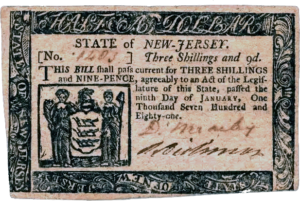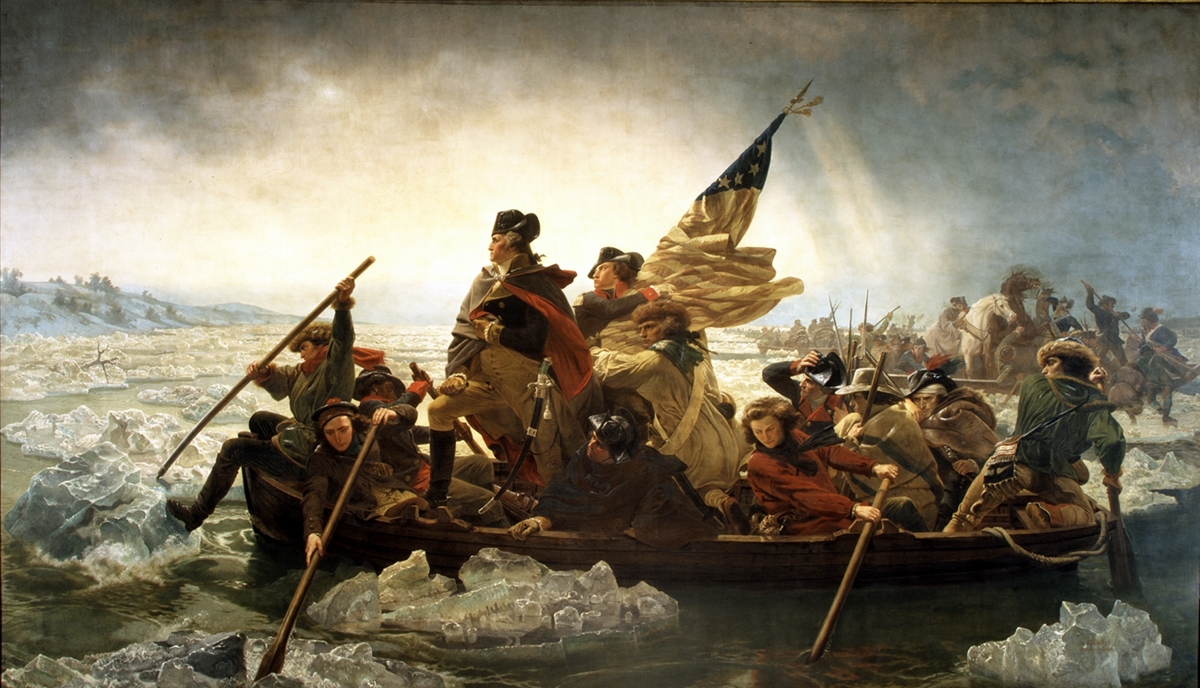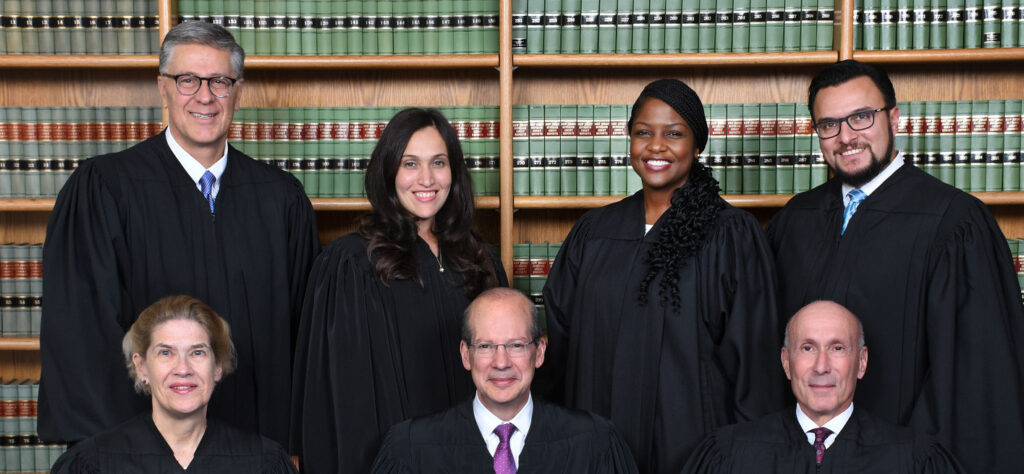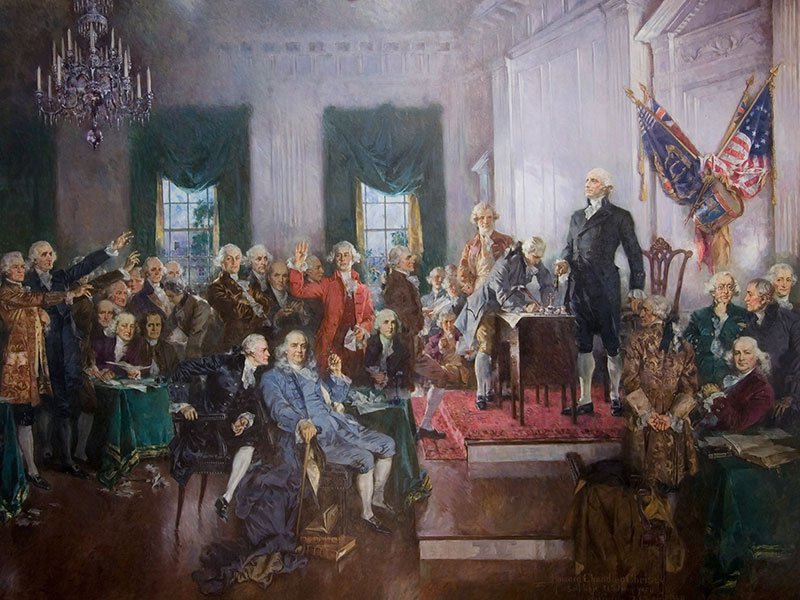
Some New Jersey Freemasons, and many others I’m sure, have visited Brearley Lodge in Bridgeton, New Jersey at one time or another. Some readers may be members of the Lodge. Freemasons claim it is the oldest Lodge building in the state still in use and kept up by its membership. Warranted October 28, 1790, it retains the appellation Brearley No. 2. It is an old building, with no central air (I can attest to that having visited in the summer) but with many interesting old Masonic items to admire and ponder over. Its namesake, of course, is one David Brearley, a little known founding father elected first Grand Master of the newly formed Grand Lodge for the State of New Jersey in December of 1786.
Brearley Lodge No. 2, Warranted October 28, 1790
It’s Mansard roof covers an impressive ceiling made of tin. Firmly anchored across the main room, two cables with turnbuckles prevent the walls from spreading outward. A lot of windows, a small museum room and a kitchen in back. A cellar I’ve never been in and wonder what it holds.

The “Plain Dealer”

A few blocks away, on Broad Street is Matthew Potter’s Tavern, constructed in 1770 and still standing as a museum of sorts. It was the publishing location of the “Plain Dealer”, the first newspaper in the state and a popular gathering spot for liberty minded firebrands prior to the Revolution. An interesting place to visit but call the historical society beforehand and make an appointment.
Rutgers University Library Rare Book Collection offers an extant copy, possibly the only one, which you can view and read online in its entirety.{it is 80 pages and difficult script to read}. A 23-year-old named Ebenezer Elmer edited the tract, issuing it every Tuesday. It was copied by hand and distributed with the express purpose of supporting the often-faltering drive for American liberty.
Let’s Burn Some Tea
We have all learned of the Boston Tea Party as youngsters in school, but how many teach of the Greenwich Tea Burning? Or, the many others which took place in the colonies? Just southwest of Bridgeton stands the small, quaint, and very old town of Greenwich. Surrounded by farmers’ fields and bordering the Cohansey River, it seems too quiet to have had anything major happening there.

A monument on Greate Street, Greenwich marks the event with the names of those involved chiseled in.
Photo credits: By Smallbones – Own work, Public Domain, https://commons.wikimedia.org/w/index.php?curid=10696868
But it is deceiving, that quaint appearance. Theirs’ was the last tea burning to occur. It took place on December 22, 1774, three days before Christmas. It is also the least well known. They took tea stored in a cellar from a ship the “Greyhound” and set it ablaze. One participant, Ebenezer Elmer, we heard of before, was editor of the “Plain Dealer”. Another, Richard Howell, would become the third Governor of the state. As an aside, his daughter Varina would marry Jefferson Davis of the Confederacy.
Numismatic Ties to David Brearley
What initiated my interest in David Brearley was my focus on numismatics and particularly in colonial and continental paper notes among which some from New Jersey, I discovered, have his signature. Found in auctions and coin and currency dealers’ stocks, many of these notes from the 1700’s have survived in various states of preservation. Most are hand signed by two or three men, typically judges, sheriffs or people of some political or social influence. Produced in different denominations, they amounted to tens of thousands in circulation. Imagine signing your name thousands of time over.

A 1773 Fifty Shilling Note from the Pennsylvania Colony. Printed By Hall & Sellers. David Hall partnered with Ben Franklin until 1748 when Franklin sold to Hall. Hall partnered with William Sellers in 1766.
Many notes from the mid 1700’s of Colonial Delaware and Pennsylvania were printed by Benjamin Franklin and David Hall but they never signed any. Notes printed after the Continental Conventions and authorized by the Continental Congress are considered Continental Currency. The term “Not worth a Continental” was coined due to its rapid depreciation. Paul Revere of Boston engraved the plates for the first of them. These depreciated quickly due to unrestricted printing and the Congress forcing the colonies to use them to pay for the war. Inflation soared so the colonies wished to continue printing their own as well.
Colonial Paper Money

David Brearley boldly signed a New Jersey issued note in red ink, dated January 9, 1781. Notice the value of this note. They are still using the British octal system. The dollar and it’s ten base decimal system does not come into general use until the 1790’s.
The date also specified the date of the Act of Legislature authorizing it’s manufacture, not it’s actual printing. The lower signature, difficult to read is by one Philemon Dickinson. Dickinson, younger brother to founding father John Dickinson, rose to major general and was appointed to command of all NJ militia in 1777 and received high praise from General Washington for his actions in the war leading the “Jersey Blue”. He served as a delegate from Delaware at the Continental Congress of 1782 and served as a Senator in the New Jersey Legislature owning property in both states.
Agitation leads to revolution
In 1764 Britain placed a ban on the issue of paper money in the colonies, The Currency Act of 1764, a move which contributed to much discontent among the colonists. It did not stop them from denying the Governor of their state his salary or holding up appropriations until he could convince the King to sign an Act authorizing issuance of new paper money. The strength of that colony’s economy set the value of its currency against others. A good example is Virginia, a large colony whose economy was strong due to the tobacco crop while other, smaller colonies with weaker economies would see their scrip worth less.
Revolution and the Jersey Blues
The colonies, for their protection, formed militias made up of male residents who were men of all backgrounds and professions. Many were farmers, merchants, and those who were not British sympathizers were called to help in the war. The NJ militia played a large part in actions within the state and adjoining states.
While Brearley’s older brother Joseph, a captain of the Jersey Line in the Continental Army, was sent to Canada in early 1776 on the ill-fated attempt to capture Quebec, David was mixing his militia duties with a busy law practice. But, in June of that year, in response to a call from the Continental Congress, Brearley was deployed as lieutenant colonel of the 1st Battalion under Colonel Nathaniel Heard to reinforce General Washington’s army in New York.
The 1st saw action in New York, Brandywine Pa, Monmouth and spent much of the winter of ’78 in Valley Forge. Ironically, very few Jersey Blues took part in the most famous battle in their state. That would be the Battle of Trenton.

The famous painting by Emanuel Leutze of Washington Crossing the Delaware. It makes me want to yell “sit down fool, you’ll surely fall in and drown”. I am confident he did not stand in a small boat in the middle of a northern winter.
Chief Justice Brearley
Brearley was chosen by the legislature to serve as Chief Justice on the State’s highest court and resigned his commision in March 1780. The court in that era worked a bit differently then it does today. It had jurisdiction over; original common law cases, including debt and trespass; treason and sedition during the Revolutionary War; naturalization during the colonial period; appeals, including cases from the Courts of Common Pleas. Also, the County Circuit Court was presided over by a Justice of the Supreme Court. This required a lot of travel on horseback or carriage.
The present New Jersey Supreme Court. Chief Justice Stuart Rabner is center front. Going clockwise; Anne Patterson, Douglas Fasciale, Rachael Apter, Fabiana Pierre-Louis, Michael Noriega & Lee Solomon

The Honorable Justice Brearley served on this court until 1789. He traveled as far south as Salem and north to ??”??. During his term on the Supreme Court he made what was the first practice of judicial review in the country. This important decision came in the case known as Holmes v. Walton and affords us protection to the present day. The case centered on a pair of merchants who had been accused of trading with the enemy. They were convicted by a justice of the peace under the 1778 Seizure Law that allowed for a six man jury according to a statute passed in 1775. Brearley declared this statute void as the NJ constitution, as flawed as it was at the time, required a jury of twelve.
Overshadowed and forgotten
There is no contemporary reporting of this decision. Most likely it was delivered orally and was overshadowed by a similar decision in Rhode Island six years later(Trevett v. Weeden). Eventually, it became precedent in the Marshall Supreme Court of the United States. This keeps the legislature from running roughshod, at will, over the citizens of the land(you and I).

A well known painting by Howard Chandler Christy of the Constitutional Convention in Philadelphia, 1787
Delegate to the Constitutional Convention; Historical Context of the Constitutional Congress
The Constitutional Congress of 1787 emerged from a confluence of factors that highlighted the inadequacies of the Articles of Confederation. Initially adopted in 1781, the Articles established a loose federation of sovereign states, which soon revealed significant shortcomings, particularly regarding the federal government’s inability to impose taxes, regulate commerce, or maintain a standing army. This incapacity fostered economic disarray, prompting various states to enact protective tariffs, leading to trade disputes among them.
Furthermore, the post-war period saw escalating tensions among the states, exacerbated by economic instability and a growing sense of urgency for reform. The inability of Congress to act decisively during critical junctures, such as Shays’ Rebellion in 1786, underscored the necessity for a more robust federal structure capable of maintaining order and promoting national stability. In light of these challenges, the call for a constitutional convention gained momentum as a means to devise a stronger government framework.
The Virginia Plan Vs. The New Jersey Plan
The Constitutional Congress 1787, was marked by significant debates regarding representation and the distribution of power among the states. Central to these discussions were two competing proposals: the Virginia Plan and the New Jersey Plan. The Virginia Plan, supported predominantly by representatives from larger states, advocated for a system of representation based on population. This approach aimed to allocate more power to states with larger populations, reflecting their demographic weight in the new legislature. Proponents of this plan believed that a population-weighted representation would ensure that the interests of the majority were adequately represented, thereby fostering a more democratic governance structure.
Conversely, the New Jersey Plan, favored by smaller states, called for equal representation regardless of size. This plan proposed that each state, irrespective of its population, would have an equal vote in the legislative process. Advocates of the New Jersey Plan argued that equal representation was essential to protect the interests of smaller states from being overshadowed by their larger counterparts. They feared that a population-based system would undermine their influence and leave them vulnerable to majority rule, ultimately jeopardizing the balance of power among the states.

The infamous three-fifths compromise. The 1868 14th Amendment superseded this clause and repealed the compromise explicitly.
The contrast between the Virginia and New Jersey Plans exemplified a broader tension within the Constitutional Congress: the struggle to balance the interests and voices of both large and small states. These debates led to the formation of a bicameral legislature, incorporating elements of both plans—a compromise that established a House of Representatives with population-based representation and a Senate granting equal representation to each state. This structure was intended to foster cooperation and mitigate conflict between states of varying sizes, laying the foundation for the United States’ legislative framework.
The Committee of Postponed Parts
David Brearley was chosen to chair what would become one of the most important committees during the entire convention. It was called “The Committee of Postponed Parts” or “The Committee on Leftovers” and dealt with issues not resolved by the other committees who repeatedly came to an impasse with them. They were difficult issues and Brearley’s committee settled several debates on how the government should work. Members of the committee were eleven and included; Abraham Baldwin (GA)
David Brearly (NJ)
Pierce Butler (SC)
Daniel Carrol (MD)
John Dickinson (DE)
Nicholas Gilman (NH)
Rufus King (MA)
James Madison (VA)
Gouvernour Morris (PA)
Roger Sherman (CT)
Hugh Williamson (NC
Take notice only 11 states are represented on the committee when all states attending were to be represented. Maine was claimed to be part of Massachusetts and New Brunswick. Vermont was not yet a state but an independent entity and Rhode Island refused to send delegates. They feared a powerful government. Rhode Island refused to ratify the document until the other states threatened to treat it as a foreign country. It was eventually ratified by all states in 1789.
Those issues settled by the Committee
The committee moved some power from the executive to the legislature giving them the power to appoint ambassadors, the power to declare war and to raise and support armies. They dealt with relations with the Indian tribes, and Franklin’s compromise to require money bills to originate in the house. The invention of the Electoral College was one of the Convention’s most innovative achievements, and due to its complexity it would have been unlikely to come about through the debate of the full Convention.[1] The Committee on Unfinished Parts conceived this novel idea, and its members, Mr. Morris and Mr. Brearley especially, convinced the full Convention of its justifications and benefits.[2] The office of the Vice President they created and spelled out the responsibilities of the office. The president’s term was shortened from seven years to four, but he was given the ability to run for another term and finally they dealt with patent and copyright regulation. They accomplished all this in under two weeks then signed the finished product.
Of the 55 delegates that attended the convention, out of the 74 chosen, 39 stayed to sign the finished product. David Brearley was among them.
Conclusion
Personality wise, I found what I read about Brearley was this; he seems a courageous and intelligent man, yet underspoken and even tempered. Always willing to serve his state, country, community and church yet reports of the Constitutional Convention describe him as one with not much to say in debate. It seems he may have been satisfied being an advisor and assist behind the voice which would have been Patterson, the then current Governor of New Jersey and outspoken voice in the debates. As to chairing the Committee of Unfinished Parts, If there are minutes, I have not seen or found them yet, He was obviously well respected throughout the state and outside the state being selected as the first Federal Attorney for the District of New Jersey in 1789 by President Washington himself whom he had numerous opportunities for personal correspondence with throughout the revolution and convention as well as with other well known figures of the era. He served only a short time as District Attorney being consumed by an unknown mortal ailment at what we would consider today the young age of forty-five in 1790. He did keep a journal, incomplete and lacking great detail according to an author, Donald Scarini of “David Brearley and the Making of the United States Constitution”. It is reportedly in poor shape and access is restricted in a midwest university.(The book is loaned out and any errors about the journal will be fixed when it is returned)

Another important name on NJ colonial currency is John Hart(center sig). As a delegate representing the New Jersey Colony to the 1776 Continental Congress, Hart signed the Declaration of Independence. (this note is certified PMG 53 About Uncirculated with well preserved signatures))
